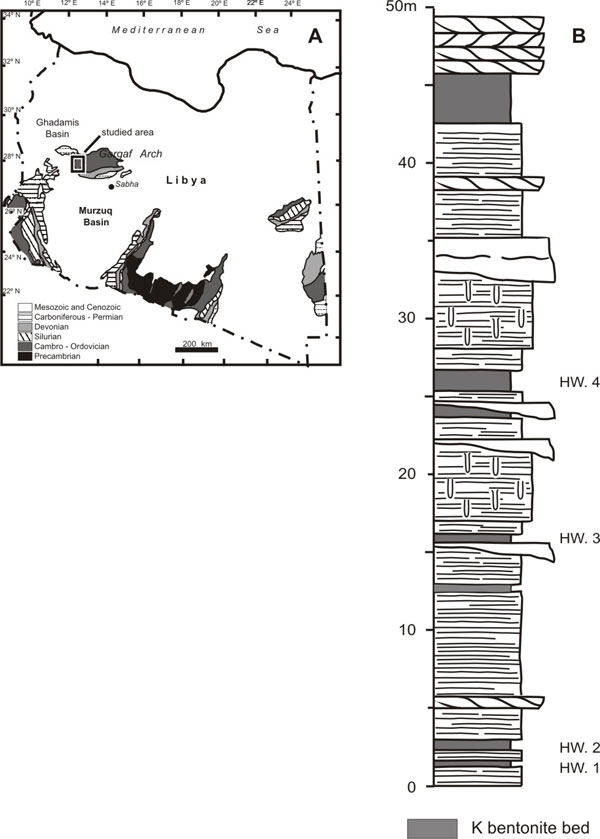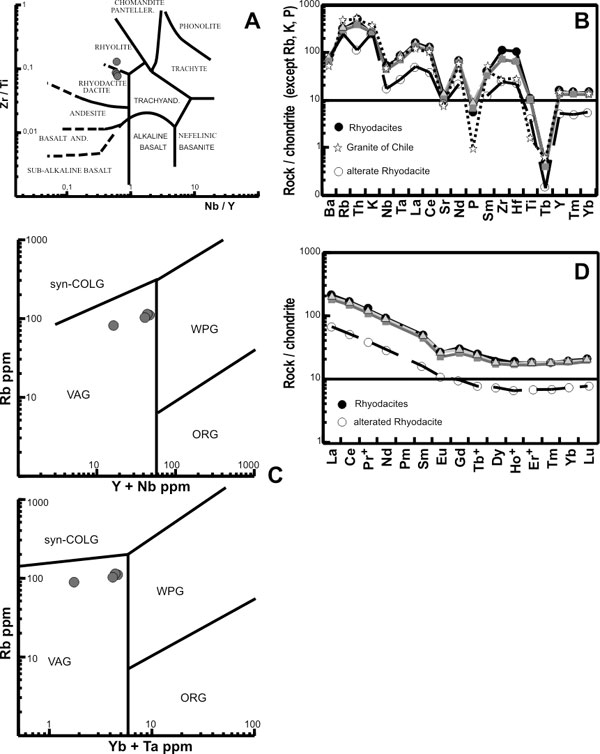
Middle Ordovician K–bentonite beds in the Murzuq Basin (Central Libya)
Emilio Ramos1, Mariana Navidad2, Mariano Marzo1 and Néstor Bolatti3
1 Departamento de Estratigrafia y Paleontologia, Universitat de Barcelona. c/ Martí i Franqués, s/n. 08028 Barcelona, España. E–mail: emilio.ramos@ub.edu
2 Departamento de Petrologia y Geoquímica, Facultad de Geologia, Universidad Complutense. 28040 Madrid, España.
3 REPSOL–YPF, Pso. de la Castellana 278–280, 28046 Madrid, España.
Key words: K-bentonites. Middle Ordovician. Hawaz Formation. Murzuq Basin. Libya.
Introduction
During early Palaeozoic times, the northern boundary of Gondwana constituted a continental margin bounded by a wide marine platform. During the Ordovician, this margin was submitted to extension which originated a set of microplates formed by continental crust (Avalonia, Armorica and Cimmerian) which drifted northwards up to collide with Laurentia, Baltica and Siberia plates (McKerrow and Scotese, 1990; Unrug, 1997; Franke, 2001; Matte, 2001).
Ordovician extension controlled the sedimentation in the northern margin of Gondwana, which included present day North Africa. Therefore, the Ordovician sedimentary record shows major thickness variations (Klitzsch, 2000), from 2,500 m in the Morrocan Anti Atlas to non–existent in some of the north Saharian intracratonic basins.
The Murzuq Basin is an intracratonic basin located in central Libya (Figure 1.A). Its Palaeozoic sedimentary infill is more than 2000 m thick. The Ordovician sedimentation was controlled by extension which divided the zone in a set of horst and grabens (Klitzsch, 2000).
The Palaeozoic sedimentary record of the Murzuq Basin has been divided in a set of lithostratigraphic units (Davidson et al., 2000). The Middle and Late Ordovician ones are oil–bearing formations actually in production. For this reason subsurface information is abundant.
The Hawaz Formation, Middle Ordovician (Llarvirnian–Llandeillian) in age (Miles, 2001), has been recognized both, in the subsurface, and in outcrops along the basin boundaries. In the Gargaf high, in the northern part of the basin (Figure 1A), a 50 m thick succession of the Hawaz Formation has been studied (Figure 1B). This succession consists mainly of fine to medium–grained quartzitic sandstone beds deposited in a shallow marine, tidal–influenced environment. Within this sandstone succession, a number of K–bentonite beds have been recognized.
K–bentonite beds
The K–bentonite beds are commonly grouped into couplets K–bentonite–sandstone beds, where individual K–bentonite beds have thicknesses ranging from 10 to 20 cm. Ocassionally, beds up to 1 m thick have been recognized, but these are not well exposed, and it is not possible to differenciate if they record single or a suite of eruptive phenomena. In the stratigraphic section (Figure 1.B) only the seven main K–bentonite beds or sets of beds are represented.

Figure 1. A. Geological map of Libya indicating the outcropping Palaeozoic rocks, the location of the Murzuq Basin and the studied area in the Gargaf High. B. Studied section of the Hawaz Formation in the Gargaf area and location of the studied samples.
The most common, 10 to 20 cm thick, K–bentonite beds fossilize rippled tidal sandstones. They are plane–laminated to massive and, in contrast with the sandstones, they are unbioturbated. Four samples of different K–bentonite beds (HW.1 to HW.4 in Figure 1.B) have been studied.
Analytical procedure
Thin sections, X–ray diffraction and geochemical analysis have been carried out for each sample. The <mm fraction was separated, and oriented mounts were prepared for X–ray diffraction. Clay mineralogy was determined from diffraction patterns obtained using samples that were air dried, ethylene glycol solvated and heated to 550ºC. X–ray diffraction analyses were carried out on a Siemens D500 X–ray diffractometer using CuK a radiation.

Figure 2. A. Classification of the Libyan Ordovician volcanic rocks on the Winchester and Floyd (1977) diagram. B. Spiderdiagram of the Ordovician volcanic rocks compared with an andesine granite. Normalized to Thompsom et al. (1984). C. Geodynamic setting of Ordovician volcanic rocks after Pearce et al. (1984). VAG = volcanic arc granites. syn–COLG = syn–collision granites. WPG = intraplate granites; ORG = ocean ridge granites.D. Chondrite– normalized REE. Normalization factors after Evensen et al. (1978).
The chemical analyses were performed in the CRPG–CNRS anaytical center at Nancy (France). The major elements were determined with emission spectometry and atomic absortion and the trace elements by the mass spectometry making use of international standards.
Petrography
The studied samples are light colored felsic rocks and show lamination defined by opaque minerals. They have a coarse texture formed by 1 mm porphyroclasts of angular quartz, acid plagioclase (albite) and potassium feldspar. They are included in a sericitic matrix with abundant white mica crystals forming laminae. Iron oxides are also frequent. Tourmaline, idiomorphic zircon, leucoxene and biotite are present as accessory minerals.
X–ray diffractometry of the <mm fraction indicates that the major clay constituent is kaolinite. Other clay mineral constituents are negligible.
Geochemistry
The Libyan volcanic rocks represent the acid–intermediate members, rhyodacites and rhyolites (Figure 2.A), of a calcalkaline sequence with high potassium content (K20> 3,5 %, Pecerrillo and Taylor, 1976). They are characterized by high silica (SiO2>69%), alumina (Al2O3= 14 to 18%), potassium and zirconium (480 to 792 ppm) content.
The chondrite normalized values of their trace elements (Thompson et al., 1984, Figure 2.B), denote profiles characterized by a high content in transition elements, with negative anomalies in Nb, Ta, Sr, P and Tb. These spectrums are similar with respect to high and low incompatibility elements to the reported by Pearce et al. (1984) from the Chilean granites belonging to a continental margin of andine type. However, they show a crustal signature indicated by their enrichment in transitional elements (Sm, Zr, Hf, Ti). Similar spectrums to these have been related by Thompsom et al. (1984) with continental leucocratic magmas mixed of crust and mantle. On the other hand, the Libyan sample values plotted in the Pearce et al. (1984) graphs Rb – Y+Nb and Rb – Yb+Ta (Figure 2.C), also suggest an origin related to a compressive margin.
The content in rare earth (SREE) ranges between 200 ppm and 240 ppm. Their spectrums normalized to chondrite (Evensen et al., 1978) (Figure 2. D) are poorly fractionated and show an enrichment in LREE compared to HREE (LREE/HREE =10) as well as a negative anomaly in europium (Eu/Eu* between 0,60 and 0,70), indicating feldspar fractionation. The lack of HREE fractionation also suggests the presence of garnet in the source.
All the analyzed rocks have the same characteristics except the sample HW.4 which corresponds to an iron–rich and aluminium–poor rhyolite. This sample is impoverished in trace elements and LREE compared with the other samples, but their profiles show the same anomalies and are similars to the rest of the samples. These characteristics suggest that probably secondary alteration processes are involved in this elements loss.
Conclusions
The shallow marine, tide dominated, sandstones of the Hawaz Formation in the Murzuq Basin are interbedded with several K–bentonite beds. Associated achritarch microfossils indicate that the sandstones and interbedded K–bentonites are Middle Ordovician in age.
These K–bentonite beds were derived from alteration of volcanic ash fall. The Middle Ordovician volcanism was explosive; and formed by calcalkaline acid members potassium–rich. They show a chemistry composition similar to the crustal melt althought they preserve the negative anomaly in Nb and Ta that indicate a subductive character probably related with a previous geodynamic setting. However its origin is related with extension produced at Middle Ordovician times, which was responsible for the generation of a set of basins in the northern Gondwana margin.
Secondary processes of hydrothermal alteration and lixiviation have obliterated their original chemistry.
In contrast with its associated sedimentary sandstones, the K–bentonite beds have a clearly different mineralogical composition. Their higher K, U and Th content implies clear gamma–ray peaks on the wireline logs and constituted good marker beds for subsurface correlation.
References
Davidson, L., Beswetherick, S., Craig, J., Eales, M., Fisher, A., Himmali, A., Jho, J., Mejrab, B. and Smart, J. 2000. The structure, stratigraphy and petroleum geology of the Murzuq Basin, southwest Libya. In: Sola, M.A. and Worsley, D. (Eds.) Geological Exploration in Murzuq Basin. Elsevier Science, Amsterdam. p. 295–320.
Evensen N. M., Hamilton P. J and O´Nions R. K. 1978. Rare earth abundances in chondritic meteorites. Geochim. Cosmochim. Acta, 42: 1199–1212
Franke, W. 2001. The mid–European segment of the Variscides: tectono–stratigraphic units, terranes boundaries and plate tectonic evolution. J. Geol. Soc. London, 197, 35–61.
Klitzsch, E.H. 2000. The structural development of the Murzuq and Kufra Basins–significance for oil and mineral exploration. In: Sola, M.A. and Worsley, D. (Eds.) Geological Exploration in Murzuq Basin. Elsevier Science, Amsterdam. p. 143–150.
Matte, P. 2001. The Variscan collage and orogeny (480–290 Ma) and the tectonic definition of the Armorica microplate: a review. Terra Nova, 13, 122–128.
McKerrow, W.S. and Scotese, C.R. (Eds.) 1990. Palaeozoic palaeogeography and biogeography. Geol. Soc. London Spec. Mem. Nº 12.
Miles, N.H. 2001. A palynological correlation of the Palaeozoic. ROBERTSON internal report for REMSA, 95 pp.
Pearce, A., Harris, B. W and Tindle., A.G. 1984. Trace element discrimination diagrams for the tectonic interpretation of granitic rocks. Journal of Petrology, 25 (4): 956–983.
Pecerrillo A., and Taylor, S. R. 1976. Geochemistry of eocene calcalkaline volcanic rocks from the Kastamonu area. Northern Turkey. Contr. Mineral Petrol., 58: 63–81.
Thompson, R. N., Morrison M. A., Hendry G. L and Parry, S. J. 1984. An assessment of the relative roles of crust and mantle in magma genesis: an elemental approach., Phil. Trans. R. Soc. Lond. A 310: 549–590.
Unrug, R. 1997. Rodinia to Gondwana: The geodynamic map of Gondwana supercontinent assembly. GSA Today, 7, 1–6.
Winchester, J.A and Floyd, P.A. 1977. Geochemical discrimination of different magma series and their differentiation products using inmobile elements. Chem. Geol, 20: 325–343
Received: February 15, 2003
Accepted: June 15, 2003